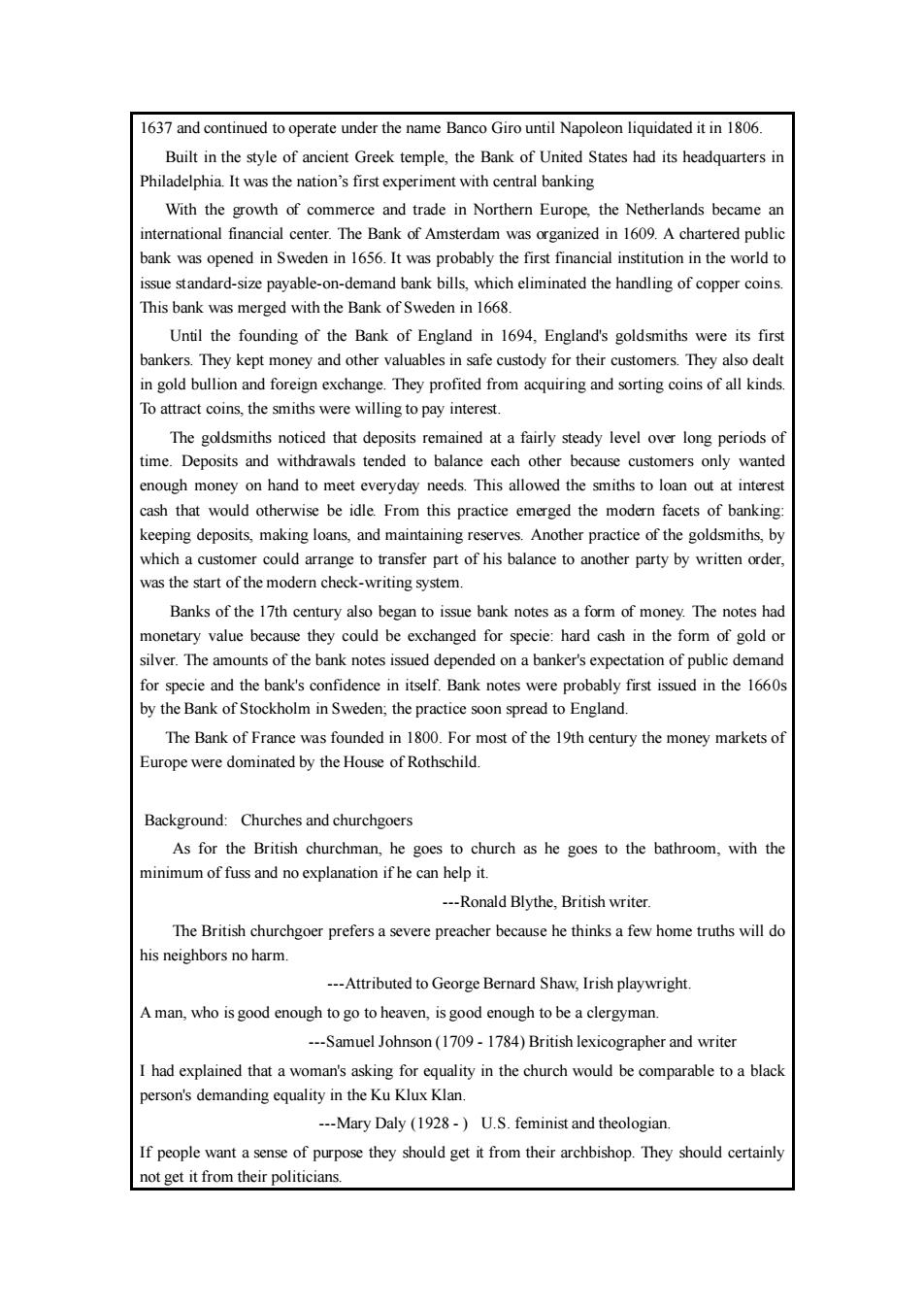正在加载图片...

1637 and continued tooperate under the name Banco Giro until Napoleon liquidated it in1806. Built in the style of ancient Greek temple,the Bank of United States had its headquarters in Philadelphia.It was the nation's first experiment with central banking With the growth of commerce and trade in Northem Europe,the Netherlands became an international financial center.The Bank of Amsterdam was organized in 1609.A chartered public bank was opened in Sweden in 1656.It was probably the first financial institution in the world to issue standard-size payable-on-demand bank bills,which eliminated the handling of copper coins This bank was merged with the Bank of Sweden in668. Until the founding of the Bank of England in 1694,England's goldsmiths were its first bankers.They kept money and other valuables in safe custody for their customers.They also dealt in gold foreign exchange.They profed kinds To attract coins,the smiths were willing to pay interest. The goldsmiths noticed that deposits remained at a fairly steady level over long periods of time.Deposits and withdrawals tended to balance each othe ners only wante enough money on hand to meet everyday needs.This allowed the smiths to loan ou at interes cash that would otherwise be idle From this practice emerged the modern facets of banking keeping deposits,making loans,and maintaining reserves.Another practice of the goldsmiths,by which a customer could arrange to transfer part of his balance to another party by written order was the start of the moder check-writing system Banks of the 17th century also began to issue bank notes as a form of money.The notes had monetary value because they could be exchanged for specie:hard cash in the form of gold or silver.The amounts of the bank notes issued depended on a banker's expectation of public demand for i and the banks fi t Bank notes were probably first issued by the Bank of Stockholm in Sweden,the practice soon spread to England. The Bank of France was founded in 1800.For most of the 19thcentury the money markets of Europewere dominated by the House of Rothschild. Background:Churches and churchgoers As for the British churchman,he goes to church as he goes to the bathroom,with the minimum of fuss and if he can help it. -Ronald Blythe,British writer. The British churchgoer prefers a severe preacher because he thinks a few home truths will do his neighbors no harm. Attributed to George Bernard Shaw,Irish playwright A man,who is good enough to go to heaven,is good enough to be a clergyman. -Samuel Johnson(1709-1784)British lexicographer and writer I had explained that a woman's asking for quality in the church would be comparable to a blac person's demanding equality in the Ku Klux Klan. -Mary Daly (1928-)U.S.feminist and theologian. If people want a sense of purpose they should get it from their archbishop.They should certainly not get it from their politicians. 1637 and continued to operate under the name Banco Giro until Napoleon liquidated it in 1806. Built in the style of ancient Greek temple, the Bank of United States had its headquarters in Philadelphia. It was the nation’s first experiment with central banking With the growth of commerce and trade in Northern Europe, the Netherlands became an international financial center. The Bank of Amsterdam was organized in 1609. A chartered public bank was opened in Sweden in 1656. It was probably the first financial institution in the world to issue standard-size payable-on-demand bank bills, which eliminated the handling of copper coins. This bank was merged with the Bank of Sweden in 1668. Until the founding of the Bank of England in 1694, England's goldsmiths were its first bankers. They kept money and other valuables in safe custody for their customers. They also dealt in gold bullion and foreign exchange. They profited from acquiring and sorting coins of all kinds. To attract coins, the smiths were willing to pay interest. The goldsmiths noticed that deposits remained at a fairly steady level over long periods of time. Deposits and withdrawals tended to balance each other because customers only wanted enough money on hand to meet everyday needs. This allowed the smiths to loan out at interest cash that would otherwise be idle. From this practice emerged the modern facets of banking: keeping deposits, making loans, and maintaining reserves. Another practice of the goldsmiths, by which a customer could arrange to transfer part of his balance to another party by written order, was the start of the modern check-writing system. Banks of the 17th century also began to issue bank notes as a form of money. The notes had monetary value because they could be exchanged for specie: hard cash in the form of gold or silver. The amounts of the bank notes issued depended on a banker's expectation of public demand for specie and the bank's confidence in itself. Bank notes were probably first issued in the 1660s by the Bank of Stockholm in Sweden; the practice soon spread to England. The Bank of France was founded in 1800. For most of the 19th century the money markets of Europe were dominated by the House of Rothschild. Background: Churches and churchgoers As for the British churchman, he goes to church as he goes to the bathroom, with the minimum of fuss and no explanation if he can help it. -Ronald Blythe, British writer. The British churchgoer prefers a severe preacher because he thinks a few home truths will do his neighbors no harm. -Attributed to George Bernard Shaw, Irish playwright. A man, who is good enough to go to heaven, is good enough to be a clergyman. -Samuel Johnson (1709 - 1784) British lexicographer and writer I had explained that a woman's asking for equality in the church would be comparable to a black person's demanding equality in the Ku Klux Klan. -Mary Daly (1928 - ) U.S. feminist and theologian. If people want a sense of purpose they should get it from their archbishop. They should certainly not get it from their politicians